“I love what I do! The income is secondary,” says Grace Buenaventura, OD, of San Diego, in response to our 2015 Income Survey. And she isn’t the only survey respondent to express this sentiment. Beyond the rewarding nature of the work, survey respondents praise the profession for providing an excellent professional/personal life balance and advancement opportunities through its various career paths.
The good news, according to this year’s survey results, is that optometrists are also generally well compensated for their dedication to their patients and profession.
Below, take a look at the highlights from this year’s Income Survey to see just how the profession is doing—and how you compare. Nearly 900 optometrists responded from across the country, giving us a glimpse into annual salaries, based on everything from employment status and practice setting to years of practice, gender and region.
Salary Basics
The average annual income for all survey takers—both full-time (91%) and part-time (9%) practitioners—is $144,155. Full-time optometrists, both self-employed (51%) and employed (49%), reported an average annual salary of $150,123, a small 1% increase from last year’s results. Part-timers average $81,937.
Our reported annual wage for full-time practitioners came in a little high, considering the Bureau of Labor Statistics (BLS) mean wage for 2014 is $113,010.1 However, the BLS does not include self-employed optometrists, who often report higher wages. By excluding self-empoyed survey takers, our average salary drops to $116,068, just 3% higher than the BLS average salary.
The suggestion that self-employed practitioners can make more money is what often leads young clinicians down the path of practice ownership.
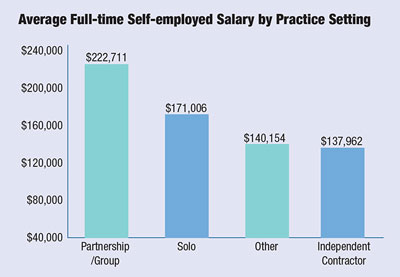 |
“I have a strong base salary but I realize that, as an employee, growth can only be so much,” says Syed Hussain, OD, who works in Laurel, Md. “I hope to transition to practice ownership in a few years.”
And no wonder, considering self-employed optometrists seem to be the heavy hitters of the profession, at least in terms of money in the bank. Their annual salary averages $182,428, according to our survey—36% more than employed doctors. Added to that, many solo practitioners say they have greater flexibility with their schedules and can work fewer days or hours a week, or make adjustments to accommodate their family needs.
“I’m able to balance work and play by seeing patients Monday, Tuesday and Wednesday only,” says Kay Royal, OD, a solo optometrist in Toccoa, Ga. “What’s not to love?”
For some, owning their own practices has lent to an easier transition into retirement.
“I reduced my hours at my choice, and my salary has remained steady overall,” says Steven R. Wilkins, OD, a solo practitioner in Virginia Beach, Va. “The private practice is only operating on a four-day work week. After 30+ years of practice, I just decided to slow down for the last five.” And why not? He earned it!
Where You Work Matters
Whether you own your own practice or not isn’t the end of the story. Your practice setting can have a huge impact on your salary as well. Self-employed optometrists who work within a partnership or group (31% of all self-employed optometrists) reported a 23% higher salary than solo practitioners, and the highest average salary of any group at $222,711. There was also a 38% pay disparity between these practitioners and independent contractors, who reported the lowest annual average salary within the self-employed category of $137,962.
For employed doctors, there was a slightly smaller disparity of 21% between the highest and lowest reported salaries—the highest was nearly a tie between those working for an HMO or PPO (who reported an average of $132,389) and those in the hospital or VA setting (who reported an averge of $132,206), and those in academia reported the lowest at $105,233.
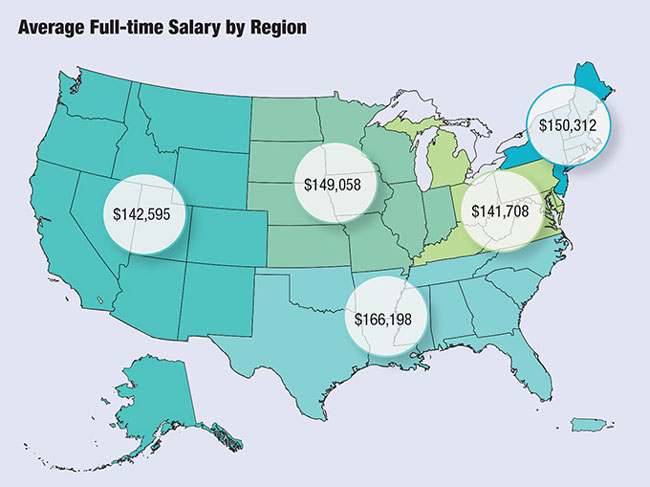 |
Location, Location, Location
In addition to variations in income due to practice setting, the region in which you live affects your take-home, too. Our survey takers provided a relatively fair representation of each region, with 13% in the Northeast, 16% in the Mid-Atlantic and Lower Great Lakes, 23% in the South, 19% in the Midwest and 29% in the West.
Practitioners in the South reported the highest annual salary of $166,198, which was 15% more than the salary reported by those practicing in the Mid-Atlantic and Lower Great Lakes region. Those practitioners averaged the lowest salary of $141,708, followed closely by optometrists in the West, who averaged $142,595. So it comes as no surprise that a self-employed optometrist from Texas reported the highest single salary of $900,000.
| “Optometry allows me to make a great living and spend time with my family.” — Daniel Koenig, OD |
Experience Pays
Another statistical no-brainer highlighted by this year’s survey is the financial benefit that comes from years in practice. Salaries rise with experience, and the survey results showed an average increase of 35% between practitioners in the field for 0-10 years vs. those practicing for 30+ years. In fact, the average salary for optometrists practicing for 30 years or more was $182,351, second only to the salary reported by self-employed optometrists in a partnership or group practice.
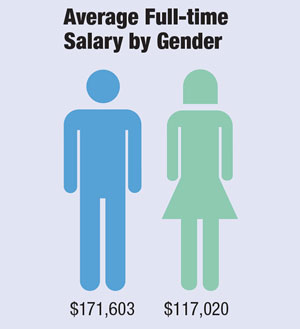 |
The Gender Gap
Unfortunately, this year’s survey provided a grim reminder that pay disparity still exists between men and women—in fact, it grew significantly from last year. Last year, men working full-time reported an average salary 59% higher than women working full-time; this year, the gap widened to 68%.
But, like last year, the survey’s demographics can, at least in part, explain some of the difference. For instance, only 7% of optometrists in the field for 30 years or more are women—and they still reported an average salary 33% lower than their male counterparts with the same experience level. That same gap was at 46% last year. In addition, 45% of survey takers have been in the field 10 years or less, 57% of whom are women. In this demographic, women reported an average salary of $108,755, 16% lower than men with the same experience. Compensation seems to be evening out, at least somewhat, for the younger generation, considering last year’s disparity was 29%.
Regardless of the glimmer of hope, the overall gap in pay is still substantial, and in desperate need of a deeper discussion beyond the scope of this reader survey.
Satisfaction
As a whole, optometrists are happy with their financial situation. Seventy percent said they are satisfied or very satisfied with their salary, and only 4% claimed they are very unsatisfied. For those who are satisfied, optometry seems to provide them the financial backing and flexibility necessary to support their chosen lifestyle. For those who are unsatisfied, student loan debt and lower reimbursements were the two biggest concerns.
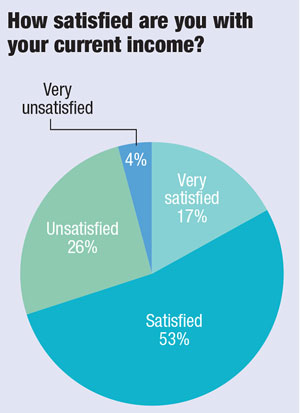 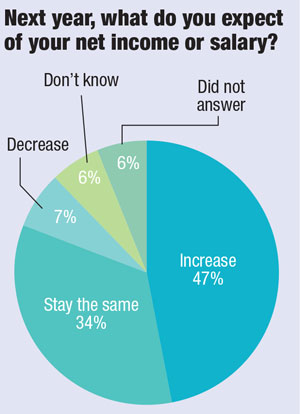 |
But the future looks bright for most. Almost half of respondents expect their income to increase over the next year, and many have a plan to help make that happen.
“My income is strictly based on how many patients I see in an employed setting,” says Justin Johnson, OD, of Belvidere, Ill. “I hope to generate word of mouth referrals for exceptional patient care.”
“Increasing my patient examinations from optical plans to medical eye examinations with ancillary testing results in a considerable increase in revenue per patient,” says Brian Kahn, OD, of Atlanta. “Because we can see only so many patients per hour and per day, maximizing the medical model in optometry provides the source of enhanced net income.”
“This year, we added a vision therapy optometrist to our practice and a medical optometrist, who will concentrate on glaucoma and dry eye disease,” says Dawn Stratton, OD, of Lexington, Ky. “We have already seen an 18% increase in gross income over a four-month period compared to last year, and our net is keeping up.”
Other plans for revenue generation include: better practice marketing with referrals, website redesign; upgrading technology; taking on extra hours; opening a new practice or transitioning into solo practice.
| “My income continues to grow about 10% per year, and this allows me to save for retirement and donate 10% to Optometry Giving Sight.” — Greg Pearl, OD |
Giving Back
While the survey asked optometrists to hone in on the financials of their career, some still found a way to remind us of the loftier goals that drive their dedication to patients and the profession. Many optometrists, including A.J. DeVivo, OD, from Ashtabula, Ohio, hope to spend more time volunteering, and not just where they live.
“My daughter and I are planning to go to Haiti in January with an OD team on a mission trip,” he says. “I am not interested in increasing income, I am going to do more volunteer work for the profession.”
But, it’s still nice to know the profession can financially support practitioners’ passion to help others, both at home and abroad.
1. Bureau of Labor Statistics. Occupational Employment and Wages, May 2014: 29-1041 Optometrists. www.bls.gov/oes/current/oes291041.htm.
